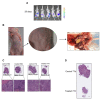In Vivo Effects of Conditioned Medium from Human Uterine Cervical Stem Cells in an Ovarian Cancer Xenograft Mouse Model
- PMID: 35985689
- PMCID: PMC9353723
- DOI: 10.21873/cgp.20341
In Vivo Effects of Conditioned Medium from Human Uterine Cervical Stem Cells in an Ovarian Cancer Xenograft Mouse Model
Abstract
Background/aim: Ovarian cancer is the most lethal of all gynecological cancers, despite advances in surgical techniques and medical treatments. During the last years, therapies based on mesenchymal stem cells and particularly their secretome (conditioned medium, CM) have emerged as promising treatments for various types of tumors.
Materials and methods: In the present study, we evaluated the in vivo antitumor effect of human uterine cervical stem cell conditioned medium (hUCESC-CM) after intraperitoneal administration in an ovarian cancer mouse model.
Results: We found that intraperitoneal injection of hUCESC-CM in immunodeficient mice, injected fifty days previously with the human ovarian adenocarcinoma SKOV-3 cell line, significantly reduced abdominal tumor growth, and significantly increased overall survival, compared to control mice.
Conclusion: hUCESC-CM could be an alternative approach to intraperitoneal treatment of ovarian cancer, either administered alone and/or with conventional chemotherapy.
Keywords: Mesenchymal stem cells; conditioned medium; ovarian cancer; secretome.
Copyright© 2022, International Institute of Anticancer Research (Dr. George J. Delinasios), All rights reserved.
Conflict of interest statement
The Authors declare the following competing interests: Francisco J. Vizoso, Roman Perez-Fernandez, and Noemi Eiró are co-inventors of a patent (“Human uterine cervical stem cell population and uses thereof”) owned by GiStem Research, of which some authors are shareholders (JS-L, SS, NE, FV, RP-F, and JS). The founding sponsors had no role in the design of this manuscript, in the collection, analyses, or interpretation of data, in the writing of the manuscript, or in the decision to publish the results.
Figures



Similar articles
-
Corneal regeneration by conditioned medium of human uterine cervical stem cells is mediated by TIMP-1 and TIMP-2.Exp Eye Res. 2019 Mar;180:110-121. doi: 10.1016/j.exer.2018.12.004. Epub 2018 Dec 15. Exp Eye Res. 2019. PMID: 30557571
-
Potential therapeutic effect of the secretome from human uterine cervical stem cells against both cancer and stromal cells compared with adipose tissue stem cells.Oncotarget. 2014 Nov 15;5(21):10692-708. doi: 10.18632/oncotarget.2530. Oncotarget. 2014. PMID: 25296979 Free PMC article.
-
Eradication of chemotherapy-resistant CD44+ human ovarian cancer stem cells in mice by intraperitoneal administration of Clostridium perfringens enterotoxin.Cancer. 2011 Dec 15;117(24):5519-28. doi: 10.1002/cncr.26215. Epub 2011 Jun 20. Cancer. 2011. PMID: 21692061 Free PMC article.
-
Treatment of chemotherapy-resistant human ovarian cancer xenografts in C.B-17/SCID mice by intraperitoneal administration of Clostridium perfringens enterotoxin.Cancer Res. 2005 May 15;65(10):4334-42. doi: 10.1158/0008-5472.CAN-04-3472. Cancer Res. 2005. PMID: 15899825
-
Xenograft Models of Ovarian Cancer for Therapy Evaluation.Methods Mol Biol. 2022;2424:275-293. doi: 10.1007/978-1-0716-1956-8_18. Methods Mol Biol. 2022. PMID: 34918301
Cited by
-
The Associations and Causal Relationships of Ovarian Cancer - Construction of a Prediction Model.Int J Womens Health. 2024 Jun 18;16:1127-1135. doi: 10.2147/IJWH.S462883. eCollection 2024. Int J Womens Health. 2024. PMID: 38912202 Free PMC article.
-
Synergistic effect of human uterine cervical mesenchymal stem cell secretome and paclitaxel on triple negative breast cancer.Stem Cell Res Ther. 2024 Apr 25;15(1):121. doi: 10.1186/s13287-024-03717-0. Stem Cell Res Ther. 2024. PMID: 38664697 Free PMC article.
-
Role of tumor microenvironment in ovarian cancer metastasis and clinical advancements.J Transl Med. 2025 May 14;23(1):539. doi: 10.1186/s12967-025-06508-0. J Transl Med. 2025. PMID: 40369674 Free PMC article. Review.
-
Emerging role of mesenchymal stromal cells in gynecologic cancer therapy.Stem Cell Res Ther. 2023 Dec 5;14(1):347. doi: 10.1186/s13287-023-03585-0. Stem Cell Res Ther. 2023. PMID: 38049868 Free PMC article. Review.
References
-
- Knisely AT, St Clair CM, Hou JY, Collado FK, Hershman DL, Wright JD, Melamed A. Trends in primary treatment and median survival among women with advanced-stage epithelial ovarian cancer in the US from 2004 to 2016. JAMA Netw Open. 2020;3(9):e2017517. doi: 10.1001/jamanetworkopen.2020.17517. - DOI - PMC - PubMed
-
- van Driel WJ, Koole SN, Sikorska K, Schagen van Leeuwen JH, Schreuder HWR, Hermans RHM, de Hingh IHJT, van der Velden J, Arts HJ, Massuger LFAG, Aalbers AGJ, Verwaal VJ, Kieffer JM, Van de Vijver KK, van Tinteren H, Aaronson NK, Sonke GS. Hyperthermic intraperitoneal chemotherapy in ovarian cancer. N Engl J Med. 2018;378(3):230–240. doi: 10.1056/NEJMoa1708618. - DOI - PubMed
MeSH terms
Substances
LinkOut - more resources
Full Text Sources
Medical
